Abstract
It provides specific theoretical guidance to enhance the enterprise’s independent innovation capabilities by studying the knowledge utilization and the evolution of innovation under different innovation strategies and revealing the law of innovation path. Based on the data of invention patents of 579 electronic information enterprises from 2010 to 2019, this paper constructs a knowledge-based network based on social network analysis to study the evolution process of density, centrality, and structural holes of knowledge. The evolution analysis of 3360 knowledge-based networks shows that the electronic information industry’s overall knowledge integration capacity is in the middle and lower reaches. The widespread knowledge reliance in the electronic information industry is small, the industry is out of the ‘capacity traps’, and diversified development has gradually become a trend. At the same time, cross-domain knowledge reorganization is increasing. The results show that the overall knowledge reliance degree of enterprises applying an exploitative innovation strategy is deeper than that of enterprises applying an exploratory innovation strategy. The knowledge integration capabilities and cross-domain knowledge reorganization capabilities of enterprises applying exploratory innovation strategies are higher than those of enterprises applying exploitative innovation strategy.
MSC:
91B82
1. Introduction
A knowledge-based view believes knowledge is valuable, scarce, and difficult to imitate. Enterprises are the entities of knowledge creation. Enterprises must enrich knowledge storage, utilization, and creative capabilities to obtain competitiveness. According to Schumpeter’s modern technology innovation theory, the knowledge-based structure is more significant than the knowledge components; in the phase of enterprise technical innovation, the significance of the fundamental knowledge components is significantly less significant than the significance of the relationships among them. Therefore, enterprises within the same industry usually tend to present a similar trajectory of technological development. The knowledge that all enterprises can obtain is called constitutive knowledge, which constitutes the knowledge base’s basic elements, namely knowledge elements. However, these knowledge elements with explicit characteristics do not bring competitive advantages. Integrating these knowledge elements and configuring the knowledge combination in a planned way is necessary to transform constitutive knowledge into structural knowledge with specific structural characteristics. The knowledge-based components are grouped into several categories. A system of regulations links the fundamental knowledge-based components inside a group. In contrast, the basic knowledge elements across groups are connected directly or indirectly by another connection to create an organization’s internal knowledge-based network (KBN) structure [1,2]. The KBN highlights the significance of the knowledge structure and the value of the knowledge’s fundamental components. It results from fusing the basic knowledge theory with contemporary technological innovation.
Technological innovation refers to knowledge creation through knowledge integration and cross-domain knowledge reorganization. Technological innovation also has the characteristics of technological reliance. The process of transforming from constitutive knowledge to structural knowledge is the process of technological innovation. Therefore, knowledge integration and combination configuration have become essential in technological innovation. Knowledge integration is critical to exploring and applying the dependency relationship of constitutive knowledge in different technical fields. From the storage and structure of based knowledge, we can see the innovation focus of enterprises, and the storage and structure of based knowledge reflect the technological innovation trajectory of the enterprise; at the same time, we can also see the degree to which the innovation path of the enterprise depends on the knowledge. The interdependence between the constitutive knowledge of different technical fields is generally unknown. It is possible to succeed only through repeated attempts and continuous exploration. Only by clarifying how an enterprise can form a unique innovation path under the existing KBN can one make full use of it to improve its innovation performance.
Scholars studied the relationship between the complexity of the KBN structure and innovation performance (IP), but they obtained opposite results [3,4]. The impact of a KBN on IP from the perspective of relevant and non-relevant diversity was analyzed [5,6]; the effect of the KBN breadth on IP was also studied [7]. There was an inverted U-shaped relationship between the aggregation of knowledge-based elements and IP [8]. Knowledge dependency relationships have diverse characteristics, and successful dependency relationship mining requires paying certain costs. How to select the knowledge elements and their combinations that can bring more technical advantages in the diversified dependency relationship and forming an innovation path conducive to their development has become the focus of enterprise knowledge combination configuration. Therefore, the existing knowledge storage and its structural characteristics not only reflect the choice of the existing technological innovation direction of enterprises, but also affect the scope and direction of future knowledge exploration and knowledge combination of enterprises under the influence of technological trajectory and innovation path dependence.
The majority of researchers have examined the connection between KBN and IP. However, few have studied the development process of the enterprise innovation path. In addition, the dual theory considers exploitative and exploratory innovation strategies as the contradictions enterprises face in the innovation process. Due to resource and capability constraints, enterprises cannot combine both innovation strategies. Different innovation strategies will emphasize different ways of knowledge utilization, the patent technology generated by the two innovation strategies will be different, and the knowledge-based structure will also be different. Therefore, the innovation paths of implementing exploratory and exploitative innovation strategies are different, so the evolution of its KBN is also different. Therefore, it is necessary to study the evolution path of a KBN under the condition of implementing exploitative and exploratory innovation strategies.
Therefore, this paper studies the use of enterprise knowledge from the perspective of a knowledge-based network and the evolutionary law of enterprise innovation path under different innovation strategies. The purpose is to discover the characteristics of an enterprise’s innovation path from the perspective of knowledge so that the enterprise can fully use the knowledge base and improve IP.
Therefore, based on the social network theory, this paper defines the connotation of knowledge-based network characteristics. Through the social network analysis method, the enterprise knowledge-based network is presented, and the research finds that the overall knowledge integration ability of the manufacturing industry is in the middle and lower levels of knowledge integration ability. The overall knowledge dependence of the industry is small, and there is a diversified development trend that gradually breaks away from the ‘ability trap’. The industry’s overall cross-domain knowledge integration ability shows a steady upward trend, and knowledge diffusion is evident. By analyzing the overall evolution process of the knowledge-based network and the evolution process under different innovation strategies, it is found that the knowledge dependence of enterprises implementing exploitative innovation strategy is higher, and the internal knowledge integration ability and cross-domain knowledge integration ability of enterprises implementing exploratory innovation strategy are more vital. The research results expand the theoretical application of social network theory in constructing a knowledge-based network of manufacturing enterprises and enriching the research methods of technological innovation. At the same time, the research results help manufacture enterprises build a complete knowledge-based network. It also helps manufacturing enterprises clarify the dual innovation strategy and has important practical significance for improving the IP of manufacturing enterprises.
Based on it, this paper studies the use of enterprise knowledge from the perspective of a knowledge-based network and the evolutionary law of enterprise innovation path under different innovation strategies. This paper aims to discover whether different knowledge integration, knowledge dependence, and cross-domain knowledge reorganization capabilities can bring heterogeneous knowledge network structures. This research also aims to discover the characteristics of an enterprise’s innovation path from the knowledge perspective. The research results can help enterprises use the based knowledge and improve IP.
2. Literature Review
2.1. Knowledge Base and Dual Innovation
Exploitative and exploratory innovations are two significant categories of enterprise technological innovation activities, which depend on developing and using old and new technologies. Dual innovation refers to the two competitors that must be considered in innovation management. Exploitative innovation refers to the company’s deeper mining based on existing information. The goal is to improve the effectiveness of existing technologies. Exploratory innovation is a technology that allows enterprises to effectively capture and use new information by breaking the boundaries of existing professional knowledge [3]. To use various knowledge acquisition methods for exploitative innovation, organizations must leverage original information to reduce the costs and risks related to innovation and improve their competitive advantages in the market and the field of original technology. The result is an increase in enterprises’ economic benefit. While participating in exploratory innovation, enterprises also penetrate various technical fields and must make technological progress. While this will increase the costs and risks associated with innovation, it will also enable enterprises to explore alternative paths by eliminating the dependence on the initial technology trajectory. Due to the basic competitiveness of enterprises, this is a new economic development pole [9]. Therefore, improving the dual innovation performance of enterprises has become the growth direction of enterprise technological innovation. Dual innovation is the key supporting factor for the sustainable development of enterprises.
According to the contemporary paradigm of technological innovation, knowledge structure is more important than knowledge content [10,11]. In technological innovation, the intrinsic relationship between knowledge-based elements can represent the reconstruction and exploitation of intellectual property and the technological innovation route of enterprises. Knowledge-based elements in technological innovation are much less important than the natural development relationship between knowledge-based elements. There is a positive correlation between enterprise IP and enterprise innovation strategy. Meanwhile, there is also a positive correlation between enterprise IP and the knowledge structure. When the knowledge structure of the enterprise is in a state of high element and low structure, the enterprise should adopt the exploitative innovation method. On the other hand, when an organization has a high knowledge structure and low elements, it should pursue exploratory innovation methods [12]. Researchers used bibliometric tools to study knowledge management. They examined the knowledge structure when enterprises carried out exploratory innovation strategies and the knowledge structure when they carried out exploitative innovation strategies [13,14]. By considering patents, researchers have studied how the attributes of knowledge organizations change over time [15]. Information search is crucial to technological innovation, and the breadth and depth of knowledge positively impact internal knowledge search. Moreover, structural defects may contribute to such beneficial results [13]. Excessive depth of knowledge search will have a negative impact on innovation performance, but the size of the knowledge base alleviates this negative impact. Excessive knowledge search will harm the innovation performance of enterprises. The depth of the information base will further expand this disservice.
2.2. Knowledge-Based Network Structure and Innovation Performance
Admittedly, knowledge management is essential, but it is also important to consider how knowledge-based organizational structure affects enterprise IP. Researchers have studied how the quality and size of the knowledge-based base enhance IP [16,17,18]. Enterprise network centrality improves new product development performance through depth and breadth of knowledge, while structural defects enrich recent product development performance through the range of knowledge [19]. In mergers and acquisitions in science and technology, the similarity between knowledge structure and enterprise IP presents an inverted U-shaped relationship. In addition, an inverted U-shaped relationship exists between enterprise IP and complementary knowledge structure [20]. In addition to network diversity, the centrality and scale of the network may increase the efficiency of obtaining and delivering information from external sources [21].
The complex KBN structure represents the complex process of enterprise knowledge integration. Enterprises may generate new information to improve their IP [3]. The KBN and IP’s knowledge-based components show an inverted U-shaped correlation [8]. KBN can act as a structural coupling role among countries and promote the coupling of market and knowledge. The innovation patterns and geographical scope of the KBN influence the coupling degree [22]. Knowledge management strives to establish a KBN at the regional level to achieve sustainable regional development [23]. The development of regional knowledge depends to a large extent on the KBN as a policy tool [24]. The industry–university–research agglomeration coefficient and average path length of the network significantly impact innovation, and the breadth of the knowledge base has a moderating effect on this impact [25]. The breadth and depth of knowledge acquisition determine the threshold effect of four knowledge acquisition strategies on innovation. The results show that the breadth and depth of the knowledge base have a decisive impact on the impact of knowledge acquisition on IP [26]. The knowledge base regulates enterprises’ dual innovation; the industry–university–research cooperation network’s structural hole significantly impacts enterprises’ dual innovation [27]. The density of the KBN has a negative impact on the enterprise’s ability to become a major developer; there is a U-shaped correlation between centralization and KBN, while decentralization is positively correlated with KBN. The density and centralization of KBN affect the ability of enterprises to become key developers through knowledge integration capabilities [28].
3. Types, Nodes, and Relationships of Knowledge-Based Networks
3.1. Types of Knowledge-Based Networks
The structure of a social network requires two elements; nodes are necessary, and relationships are essential. Nodes refer to subjects with different attitudes, opinions, and behaviors; relationships include contact, association, and groups, including kinship, work, collaboration, and similar interests and hobbies. Relationships are not nodes’ attributes but are the relevance between subjects. Everyone in society will simultaneously belong to multiple networks according to different relationships and assume different roles in other networks.
There are also differences between the KBN formed by different knowledge bases owned by enterprises. The KBN is divided into three types according to the shape of network nodes in the existing literature [29,30]. The first type of network is a subject–subject network; this type of network is to study the interaction and influence between subjects who master knowledge from the perspective of knowledge flow. Through this network, knowledge flow and knowledge dissemination can be realized. The second type of network is a subject–knowledge network, which connects the subject mastering knowledge with existing concepts, knowledge, beliefs, etc. The third type of network is a knowledge–knowledge network; this network’s relationships are between knowledge elements established based on knowledge classification or semantic classification, and this network’s nodes are knowledge. This network mainly represents the relationship between knowledge within the enterprise. The KBN in this paper refers to the knowledge–knowledge network with the knowledge-based element as the node. According to the nodes and relationships needed in the social network structure, the nodes and relationships of the KBN studied in this paper are determined.
3.2. Nodes in the Knowledge-Based Network
In patent information, patent document description items such as patent name, classification number, abstract, etc., reflect the patent information to reflect the invention and creation information of the patent. According to the international patent classification (IPC) method, there are two types of patents in China: invention and utility model. The international patent classification table contains all the types of technologies. Many researchers on the knowledge base use the first four international patent classification numbers: department, division, category, and sub-category to determine the knowledge field of the patent [3,17,31]. The first four digits of the international patent number represent different knowledge network nodes. Given the comprehensiveness and authority of the international patent classification, in this paper, the first four digits of the enterprise invention patent classification numbers are used to determine the technical field of the patent.
3.3. Relationships in the Knowledge-Based Network
The patents applied by enterprises generally involve multiple technical fields; a patent has multiple international patent classification numbers, and the relationships between different technical fields are discovered by repeated trial and error. For different technologies in the enterprise knowledge base, the relationship between the knowledge elements is based on which knowledge combination is successfully applied, and IP is improved. Therefore, if the first four international patent classification numbers exist in the same patent, it can be determined that the two knowledge nodes can be successfully combined and applied, and there is a connection between them.
4. Characteristics and Measurement of Knowledge-Based Networks
4.1. Characteristics of Knowledge-Based Networks
4.1.1. Density
Density is the closeness of the connections among the nodes of the network. The more connections among fixed-scale network nodes, the larger the network density. That is, the closer the connection among nodes, the actions and attitudes of each node will be affected mainly by other nodes. In other words, the larger the network density, the stronger the consistency of the nodes and the more similar the characteristics of the nodes [32]. In social network analysis, individual behavior can be explained by network relationship characteristics [33]. Density is one of the crucial attributes of network relationship characteristics.
The density of a KBN refers to the degree of correlation among knowledge elements in technological innovation. The larger the density of the KBN, the more the scientific researchers will be familiar with knowledge. They can grasp the knowledge, dig deeper into the relationship between various elements, and quickly integrate the knowledge elements.
4.1.2. Centrality
Centrality is another crucial indicator to describe social network relationships. Fleming (2001) believed that the central potential is the degree to which the network structure is built around a specific node or a certain number of nodes [34]. If the centrality of the network is more significant, it indicates that the social relations reflected by the network are formed around one or several subjects. For example, the structure of an organization is formed around department leaders, and there will be one or several centers in a small group. The role of characters is to connect scattered individuals. If the central figure in the group is withdrawn, the group will disappear.
The centrality of the KBN is whether the generation of new knowledge elements depends on one or several knowledge-based factors. When the enterprise’s KBN has a central node, the enterprise has core technologies and a high degree of “knowledge reliance.” When the enterprise’s KBN does not have a central node, the enterprise does not have core competitiveness, and the degree of “knowledge reliance” is lower.
4.1.3. Structure Hole
Ronald Burt was a famous sociologist and a professor of sociology and strategy at the University of Chicago business school. He defined the structural hole in 1992. He pointed out that the structural hole was a buffer equivalent to the insulator in the wireline. The benefits of the two related persons who had the structural hole between each other to the network could be accumulated, not overlapped [35]. The essence of the structural hole is a non-repetitive relationship between two contacts.
The KBN structure hole refers to the hub-type knowledge node used by enterprises in technological innovation. Hub-style knowledge nodes can break through one technology and spread radially in another technical field. The more hub-style knowledge nodes are in the KBN structure, the higher the frequency of the cross-domain flow of knowledge through “bridge” nodes, and the stronger the ability of enterprises to realize cross-domain knowledge reorganization.
4.2. Measurement of Knowledge-Based Networks
4.2.1. Density
Density is one of the crucial characteristics of the network structure. The density is the ratio of the actual number of connections in the network to the maximum possible number of connections. The calculation formula is as follows:
Among them, represents the actual number of connections in the KBN and the number of nodes in the KBN. Because the number of nodes determines the density expressed by this formula, the density of a KBN with different scales is not comparable. In this paper, we draw on the Kesselheim and Avorn [36] study to calculate the absolute network density. The calculation formula is as follows:
Among them, represents the actual number of connections in the KBN, the longest path in the network, the shortest possible path between two nodes with the longest path, and the network radius .
When we substitute to Equation (2) and simplify it, we obtain the calculation formula of density as follows:
4.2.2. Centrality
Centrality refers to the degree to which the network structure is built around a certain node or a certain number of nodes. The calculation formula is as follows:
Among them, is the maximum absolute centrality of nodes in the KBN, is the absolute centrality of each node, and is the number of nodes in the KBN. The numerator represents the sum of the maximum value of the absolute centrality of nodes and the absolute centrality differences of all nodes in the KBN. The denominator represents the maximum possible sum. The greater the centrality of the enterprise KBN, the higher the enterprise’s reliance on one or more knowledge elements. is the node with the largest absolute centrality in the KBN and is the node in the KBN.
4.2.3. Structure Hole
The structure hole represents a “bridge” node connecting two unrelated knowledge elements, and each “bridge” represents a structural hole. The calculation formula is as follows:
Among them, represents all nodes directly connected to ; represents the other node except for and , represents the connection probability of and , represents the connection probability of and , and represents the redundancy of the KBN.
5. Construction of the Knowledge-Based Network
5.1. Research Samples Selection and Data Sources
This paper takes enterprises having gone public in the Shanghai and Shenzhen stock markets of the electronic information industry of China as samples and obtains patent data from the database of the “National Key Industry Patent Information Service Platform.” Compared with utility models and design patents, invention patents have higher technological innovation and power stability. International patent organizations widely recognize them because of their strict review procedures and review standards. In related studies of Guo Guoqing and Jianfeng [37] and Croitoru [38], patent data from no less than five consecutive years were used to construct the enterprise KBN. So, in this paper, we screen 579 enterprises in the electronic information industry for ten consecutive years of invention patents from 2010 to 2019. A total of 3360 KBN are constructed.
5.2. Visualization of Knowledge-Based Networks
According to the International Patent Classification (IPC), patents are divided into six levels: department, branch, major categories, sub-categories, main group, and sub-group. In this paper, patents are classified according to major categories. If a patent belongs to two sub-categories, then there is a connection between the two sub-categories; that is, there is a connection between the two nodes. As shown in Figure 1, nodes one, two, three, and four are knowledge-based elements representing sub-categories in the International Patent Classification. When a patent belongs to sub-categories one and three, a line between one and three is formed. When a patent belongs to both sub-categories one and four, a line between one and four is formed. Other lines are formed on the same principle.
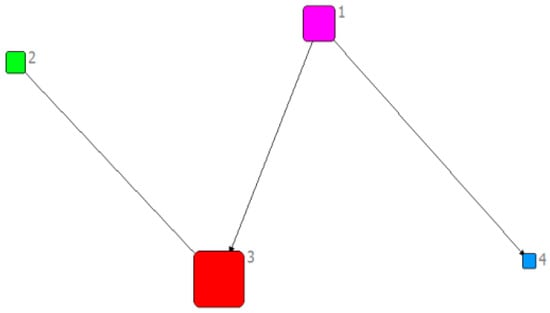
Figure 1.
Relationship among knowledge-based elements.
Through UCINNET 6.0 Jun [39], the KBN was visualized, and the characteristic coefficient of the network was calculated. We used the patent data of Heng Sheng electronics in 2015 to visualize its KBN and visually presented its appearance.
As shown in Figure 2, the nodes represent the types of basic knowledge elements, such as points G21, H10, etc., indicating the basic knowledge elements contained in a patent’s first four patent numbers. When a patent contains two basic knowledge elements simultaneously, there is a line between these two basic knowledge elements.
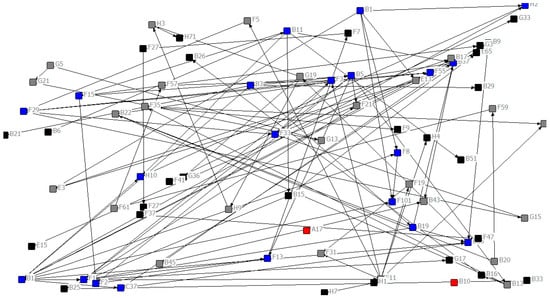
Figure 2.
Knowledge-based network visualization of Heng Sheng electronics in 2015.
5.3. Overview of the Knowledge-Based Network in the Electronic Information Industry
Figure 3 presents the number of enterprises that own patents each year. It can be seen from Figure 3 that the number of enterprises has increased year by year. The increase is large from 2010 to 2014, but the growth rate has slowed since 2015. It shows that more and more enterprises are paying attention to independent innovation, which is gradually becoming a trend to carry out business activities around independent intellectual property rights.
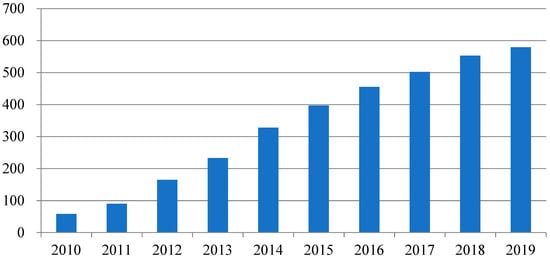
Figure 3.
Number of samples from 2010 to 2019.
Table 1 reports the maximum and minimum values of the knowledge-based elements in the KBN from 2010 to 2019.

Table 1.
The maximum and minimum values of the knowledge-based network scale.
The minimum scale of the KBN gradually becomes smaller, indicating that the newly added samples have a weak knowledge base and that the relatively technical fields are simple. Still, from the maximum scale of the KBN, the involved technical fields in the existing enterprises present a trend of diversification, and the level of diversification of technological innovation and development in the industry is relatively high.
6. Evolution of Knowledge-Based Networks
6.1. Research Method
The violin diagram combines the box plot and the kernel density map; the box plot shows the position of the quantile. The kernel density map shows the density of any position. The violin diagram lets us know which position data points gather more.
The box plot presents the quartiles of the data; that is, all values are divided into quartiles from smallest to largest, and the values at the three split points are the quartiles, where the lower quartile is equal to the 25th percentile of all values in the sample in ascending order. The middle quartile or median is equal to the 50th percentile of all values in the sample from smallest to largest. The upper quartile is equal to the 75th percentile of all values in the sample from smallest to largest. The kernel density map can be regarded as a probability density map. The vertical axis can be roughly regarded as the number of times the data appears, and the area enclosed with the horizontal axis is one. The larger the area a region occupies, the more data it contains or the larger the data value.
The violin diagram can better reflect the distribution and probability density of data, combining the advantages of the box plot and the kernel density map. The interior is a box plot, and the exterior is a kernel density map. The larger the area of the region, the greater the probability of distribution near the value.
Knowledge integration, knowledge dependence, and cross-domain knowledge reorganization capabilities reflect the enterprise’s innovation path. They also reflect the distribution of KBN density, network centrality, and structural holes when enterprises carry out different innovation strategies. The violin diagram can better reflect the data distribution and probability density, so this paper chooses the violin diagram for statistics and analyses of the data distribution.
6.2. Evolution of Knowledge-Based Network Density
The density of the enterprise KBN reflects the focus and relevance of the knowledge base. The more focused the knowledge base, the better the enterprise’s understanding of the knowledge base; the higher the knowledge relevance, the better the enterprise’s grasp of existing technology. The dynamic market demand can only be met by quickly combining the knowledge base. This paper uses stata14.0 to describe the evolution process of enterprise KBN density to reflect the use of knowledge by enterprises. According to Kabacoff, Roberti.T [40], the violin diagram combines the box plot and the kernel density map, which can intuitively reflect the difference in component data. In the violin diagram, the white dots are the median, the black box type is from the lower to the upper quartile, and the thin black line represents the whiskers.
This is a violin diagram of the KBN density in Figure 4. As seen in Figure 4, the median and lower quartile of network density continued to increase before 2013 and then began to decline and fluctuate slightly after 2014. Still, they are the same as those in previous years. The upper quartile continued to grow, especially in 2014, when it saw a significant increase, and then maintained a stable level, but there was a decline in 2019. The upper and lower whiskers were longer in different years, indicating that the density of the enterprise KBN had a relatively apparent discrete value and the distribution was somewhat uneven. After 2013, both upper and lower whiskers increased significantly.
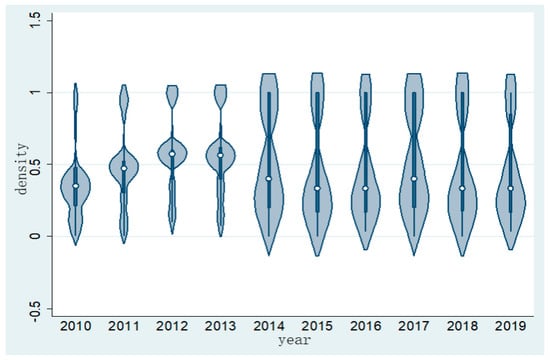
Figure 4.
Violin diagram of knowledge-based network density.
Figure 4 depicts the violin diagram with a large center and two small ends before 2013. Since 2014, the violin diagram has had a small center and two large ends. This shows that before 2013, most enterprises’ knowledge integration capabilities were average. After 2014, enterprises’ knowledge integration capabilities showed a greater degree of polarization, and two kinds of enterprises appeared, one with weaker knowledge integration capabilities and the other with stronger knowledge integration capabilities. The number of two kinds of enterprises increased at the same time. However, the number of enterprises with weaker knowledge integration capabilities was less than those with stronger knowledge integration capabilities.
Presently, the differentiation of knowledge integration capabilities in the electronic information industry is serious, and many enterprises with knowledge integration capabilities are at the middle or lower level. The electronic information industry needs to strive to improve knowledge integration capabilities. The richer the knowledge stock, the higher the possibility that enterprises can improve their IP by integrating knowledge elements from different technical fields [41].
6.3. Evolution of Knowledge-Based Network Centrality
This is a violin diagram of the KBN centrality in Figure 5. It can be seen from Figure 5 that the median and upper quartile of the centrality of the KBN began to increase in 2010, reached a peak in 2012, and then both showed a downward trend and remained stable after 2014. From 2010 to 2019, there were apparent upper mustaches, which show that the centrality of the KBN had obvious discrete values, and the distribution was relatively uneven. In 2014, significant changes began to occur, with the lower mustaches becoming smaller and the upper mustaches remaining unchanged.
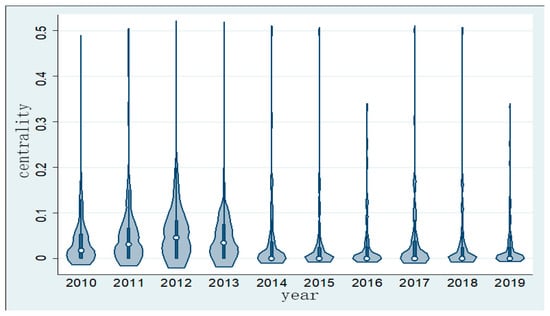
Figure 5.
Violin diagram of knowledge-based network centrality.
Judging from the appearance of the violin diagram, from 2010 to 2013, the middle of the violin diagram is large, and two ends are small, which shows that the industry centrality was below the average level and the industry’s overall core technology reliance showed a trend of first rising and then falling. After 2014, the lower whiskers of the violin diagram are larger, and the overall centrality became smaller.
The overall core technology reliance of industry has decreased; the industry has gradually escaped from the “capacity trap” and has a relatively high degree of diversification. The combination of knowledge elements can be applied to various situations. Multiple combinations of knowledge can help improve the efficiency of enterprise knowledge utilization, thereby bringing higher economic benefits. Excessive reliance on a specific combination of knowledge or knowledge elements can easily cause enterprises to neglect the exploration of the diversity of knowledge combination relationships, which is not conducive to the long-term development of enterprises.
6.4. Evolution of Knowledge-Based Network Structural Hole
This is a violin diagram of the KBN structure hole in Figure 5. As seen in Figure 6, the median and upper quartile of the KBN structure hole began to increase in 2010, peaked in 2013, and then both showed a downward trend. After rising in 2016, they declined, and in 2018 and 2019 they continuously rose. From 2010 to 2019, there are apparent upper and lower mustaches, showing evident discrete values in the KBN structural hole that were non-clustered in the KBN structural hole, and the distribution was relatively uneven.
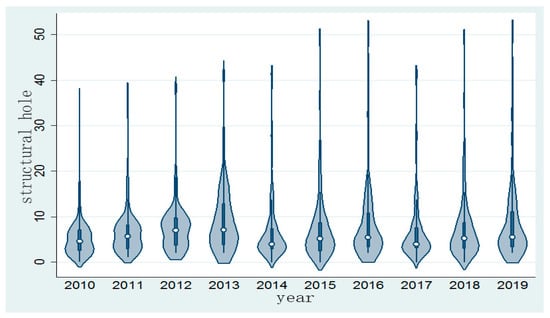
Figure 6.
Violin diagram of knowledge-based network structural hole.
Judging from the appearance of the violin diagram from 2010 to 2019, the middle of the violin diagram is large, and the two ends are small. It shows that the industry structural hole was below the average level, and the industry’s overall cross-domain knowledge reorganization ability showed a steady upward trend. This indicates that the electronic information industry’s overall cross-domain knowledge reorganization capability is improving steadily, and knowledge diffusion is evident.
Cross-domain knowledge reorganization can increase the speed of knowledge dissemination and is conducive to combining knowledge in different technical fields, resulting in significant innovations. However, the initial cross-domain knowledge reorganization will face many risks and uncertainties, so the initial cross-domain knowledge reorganization ability is weak. However, the cross-domain knowledge reorganization ability will increase with the continuous increase in knowledge integration experience. Technological breakthroughs have been made, and innovation has made a “qualitative” leap [42].
7. Evolution of the Knowledge-Based Network Based on Dual Innovation
7.1. Definition of Dual Innovation Enterprise
This article distinguishes the enterprise’s innovative development strategy from the knowledge management perspective to reflect the innovative development strategy of the enterprise. A patent is a direct manifestation of enterprise innovation and, at the same time, reflects the enterprise’s innovative development strategy. According to the literature proposed by Guan and Liu [3] to measure dual innovation, this article uses the technology categories in all enterprise patents from 1985 to 2011 as the basis. The number of patents from 2010 to 2019 is compared with the base. Comparing all types of patents each year, the number of patents with the same type added each year is regarded as exploitative innovation, and the number of new types of patents added each year is considered exploratory innovation. We define an enterprise that only has exploitative innovation as an enterprise that implements an exploitative innovation strategy. We define an enterprise that only has exploratory innovation as an enterprise that implements exploratory innovation strategy and does not consider enterprises that add two types of patents at the same time each year.
7.2. Evolution of Knowledge-Based Network Density Based on Dual Innovation
Figure 7 shows the change curve of the KBN density of enterprises with different innovation strategies. It can be seen from Figure 7 that the density of enterprises implementing the exploitative innovation strategy peaked in 2012, dropped to a minimum in 2015, and then declined except for a small rebound in 2017. The density of enterprises implementing exploratory innovation strategies has been increasing yearly, and by 2018 there was a significant decline in exploitative innovation strategies. The density of enterprises implementing an exploratory innovation strategy is higher than that of enterprises implementing an exploitative innovation strategy. The knowledge integration capabilities of enterprises implementing an exploitative innovation strategy have fluctuated slightly and remained unchanged. The knowledge integration capabilities of enterprises implementing an exploratory innovation strategy have generally increased, but there have been large fluctuations after 2018. The knowledge integration capabilities of enterprises implementing exploratory innovation strategies are stronger than that of those implementing exploitative innovation strategies.
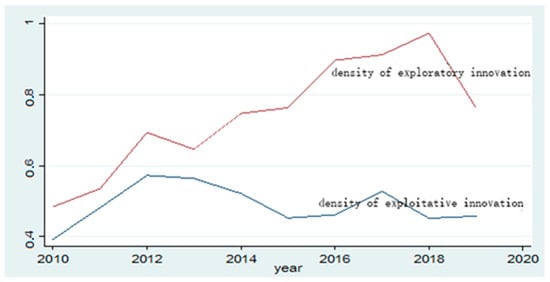
Figure 7.
Change curve of density based on dual innovation strategy.
7.3. Evolution of Knowledge-Based Network Centrality Based on Dual Innovation
Figure 8 shows the change curve of the KBN centrality of enterprises with different innovation strategies. It can be seen from Figure 8 that the centrality of enterprises implementing exploratory innovation strategies has been declining year by year, and the network centrality of enterprises implementing exploitative innovation strategies has increased year by year after a sharp decline in 2013. Additionally, from the overall point of view, the centrality of enterprises implementing the exploitative innovation strategy is significantly higher than that of the enterprises implementing the exploratory innovation strategy. This shows that the knowledge reliance of enterprises implementing the exploitative innovation strategy is higher than that of the enterprises implementing the exploratory innovation strategy, increasing yearly. The knowledge reliance of enterprises implementing exploratory innovation strategies is decreasing yearly. This phenomenon matches the connotation of exploitative innovation and exploratory innovation. Exploitative innovation refers to creating knowledge by digging deeply into the relationship between the basic elements of knowledge and having a high degree of reliance on the knowledge. Exploratory innovation refers to breaking through the boundaries of the original knowledge base and creating new knowledge so the dependence on the original knowledge is low.
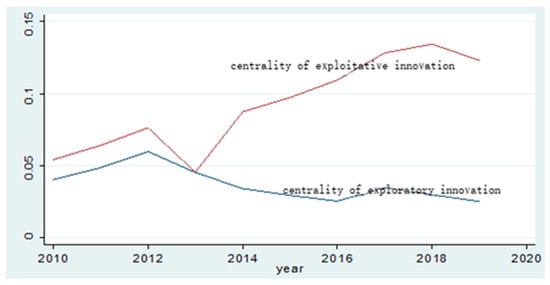
Figure 8.
Change curve of centrality based on dual innovation strategy.
7.4. Evolution of Knowledge-Based Network Structural Hole Based on Dual Innovation
Figure 9 shows enterprises’ KBN structure hole change curve with different innovation strategies. It can be seen from Figure 9 that the structural holes of the enterprises implementing the exploitative innovation strategy and the enterprises implementing the exploratory innovation strategy peaked in 2013. It continued to increase after reaching the minimum in 2014 and the maximum again in 2016.
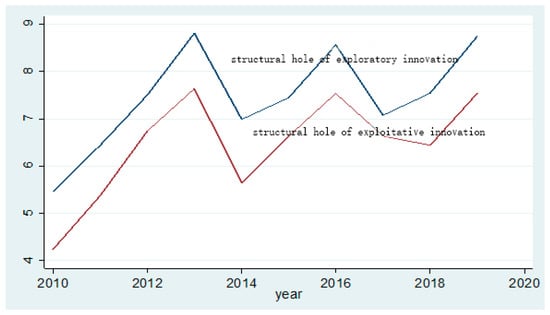
Figure 9.
Change curve of the structural hole based on dual innovation strategy.
The structural hole of the enterprise implementing the exploratory innovation strategy began to increase after the minimum value in 2017. The structural hole of the enterprise implementing the exploitative innovation strategy began to increase after the minimum in 2018. Overall, the KBN structural hole of enterprises implementing exploratory innovation strategies is higher than that of those implementing exploitative innovation strategies. The KBN structural hole of industry fluctuates rather than being linear. Enterprises implementing exploratory innovation strategies need to achieve cross-domain knowledge reorganization through the “bridge” nodes in the KBN if they want to break through the limitations of the knowledge base. Therefore, enterprises implementing exploratory innovation strategies have a larger KBN structural hole.
8. Conclusions
(1) From the perspective of the evolution process of the enterprise KBN, the knowledge integration capabilities have been differentiated to a large extent in different enterprises. On the whole, the knowledge integration ability of enterprises in the electronic information industry is equivalent, but over time, the ability of industry knowledge integration has differentiated. The knowledge integration ability of some enterprises is greatly improved. In contrast, the knowledge integration ability of some enterprises is significantly decreased, and the enterprises with weak knowledge integration ability are more than those with strong knowledge integration ability. The richer the knowledge storage is, the higher the possibility that the enterprise will improve IP by integrating knowledge elements from different technical fields. Therefore, if enterprises want to innovate performance, they must increase the storage of different knowledge to lay a solid foundation for knowledge integration and improve the probability of enterprise innovation.
(2) The overall knowledge integration capability of the electronic information industry is at the middle and downstream levels and needs to be improved. The industry is less reliant on knowledge, has a diversified development trend, and has gradually escaped the “capability trap.” The combination of knowledge elements can be applied to various contexts. The knowledge of multiple combinations can help improve the efficiency of enterprise knowledge utilization, thus bringing higher economic benefits to enterprises. Therefore, enterprises in the electronic information industry can fully use their knowledge-based elements for innovation, overcome the problem of over-reliance on one or a certain knowledge-based elements, and realize independent innovation and diversified innovation.
(3) Multiple combinations of knowledge-based elements can create more application scenarios, thereby improving the efficiency of using knowledge and improving the IP of the enterprise. Cross-domain knowledge reorganization can increase the speed of knowledge flow and enhance the efficiency of knowledge reorganization in different fields, thereby promoting significant innovations. Initially, the industry’s cross-domain knowledge reorganization faced many risks and uncertainties. Over time, the experience of cross-domain knowledge reorganization continued to increase, the enterprise’s cross-domain knowledge reorganization capabilities were enhanced, and significant breakthroughs were made in technological innovation.
(4) Enterprises implementing exploitative innovation strategies rely more heavily on overall knowledge than enterprises implementing exploratory innovation strategies. Enterprises that implement the exploitative innovation development strategy tend to innovate from the storage knowledge-based elements to avoid risk, so their knowledge dependence is higher. In contrast, enterprises implementing exploratory innovation strategy have a strong ability to take risks and are willing to explore new fields for innovation, so their knowledge dependence degree is low. Enterprises implementing exploratory innovation strategies have higher knowledge integration than those implementing exploitative innovation strategies. Enterprises implementing the exploratory innovation strategy can integrate external and internal storage knowledge for innovation, increasing knowledge variety. Therefore, if enterprises in the electronic information industry want to implement an exploratory innovation strategy, they must enhance their knowledge integration capabilities. The ability of cross-domain knowledge reorganization of enterprises that implement exploratory innovation strategies is higher than that of enterprises that implement exploitative innovation strategies. When enterprises carry out an exploratory innovation strategy, they are generally inclined to break through the boundary of knowledge to obtain new knowledge; thus, they can increase the types of knowledge to activate the creation and realize the purpose of integrating cross-domain knowledge. Finally, the enterprises can enhance creativity.
9. Limitations
The KBN reflects a wealth of enterprises’ innovation paths, but this article only analyzes the knowledge integration, knowledge reliance, and cross-domain knowledge reorganization reflected by density, centrality, and structural holes. In the future, enterprises’ innovation paths will be interpreted from other perspectives.
This article also has the following deficiencies that need to be further improved:
(1) To study the needs of sample size and data quality, this paper takes the electronic and communication equipment manufacturing enterprises with obvious innovation characteristics as the representative of manufacturing enterprises. It does not consider other high innovation output manufacturing enterprises as samples to explore the relationship between knowledge-based networks and IP. In addition, the enterprise knowledge-based network changes with the change of enterprise knowledge reserve, and different development stages of enterprises correspond to different knowledge-based networks. In the future, we will continue to study the impact of KBN in other industries on enterprise IP and the relationship between dynamic knowledge-based networks and IP.
(2) The sample listed companies in the article are relatively mature enterprises. However, due to differences in development strategies, the impact of knowledge-based networks on innovation performance may be different between manufacturing companies listed on the SME board and the New Third Board and listed companies on the main board. Then, future research can consider the impact of the KBN of manufacturing enterprises listed on the SME board and the New Third Board on IP.
Author Contributions
Conceptualization, C.L.; methodology, J.H.; software, Q.Y.; data curation, J.H. and N.K.; writing—original draft preparation, C.L. and J.H.; writing—review and editing, J.H. and Q.Y.; formal review, M.U. All authors have read and agreed to the published version of the manuscript.
Funding
This research was funded by the Major Research Project of Humanities and Social Sciences of HeBei Provincial Department of Education Funding, grant number ZD201904; the Social Science Foundation of Hebei Province, grant number HB22YJ010; the National Social Science Fund of China, grant number 21BSH052; and the Regional Economic Development Research Center of Yanshan University, grant number JJ2218.
Data Availability Statement
The datasets analyzed during the current study are available from the corresponding author upon reasonable request.
Conflicts of Interest
The authors declare no conflict of interest.
References
- Ahuja, G. Collaboration networks, structural holes, and innovation: A longitudinal study. Adm. Sci. Q. 2000, 45, 425–455. [Google Scholar] [CrossRef]
- Yayavaram, S.; Ahuja, G. Decomposability in knowledge structures and its impact on the usefulness of inventions and knowledge-base malleability. Adm. Sci. Q. 2008, 53, 333–362. [Google Scholar] [CrossRef]
- Guan, J.; Liu, N. Exploitative and exploratory innovations in knowledge network and collaboration network: A patent analysis in the technological field of nano-energy. Res. Policy 2016, 45, 97–112. [Google Scholar] [CrossRef]
- Saviotti, N.P.P. Coherence of the knowledge base and the Firm’s innovative performance: Evidence from the U.S. pharmaceutical industry. J. Ind. Econ. 2005, 53, 123–142. [Google Scholar]
- Chen, Y.S.; Chang, K. Using the entropy-based patent measure to explore the influences of related and unrelated technological diversification upon technological competences and firm performance. Scientometrics 2012, 90, 825–841. [Google Scholar] [CrossRef]
- Leten, B.; Belderbos, R.; Looy, B. Technological diversification, coherence and performance of firms. J. Prod. Innov. Manag. 2007, 24, 39–52. [Google Scholar] [CrossRef]
- Jin, X.; Chen, S.; Wang, J.; Wang, T. A Study of the Relationship between the knowledge base and the Innovation performance. BMC Cancer 2014, 1, 9. [Google Scholar] [CrossRef]
- Yayavaram, S.; Srivastava, M.; Sarkar, M. Role of search for domain knowledge and architectural knowledge in alliance partner selection. Strateg. Manag. J. 2018, 39, 35–50. [Google Scholar] [CrossRef]
- Garcia-Vega, M. Does technological diversification promote innovation? An empirical analysis for European firms. Res. Policy 2006, 35, 230–246. [Google Scholar] [CrossRef]
- Henderson, R.; Cockburn, I. Scale, scope, and spillovers: The determinants of research productivity in drug discovery. Rand J. Econ. 1996, 27, 32–59. [Google Scholar] [CrossRef]
- Henderson, R.; Cockburn, I. Measuring Competence? Exploring Firm Effects in Pharmaceutical Research. Strateg. Manag. J. 2010, 15, 63–84. [Google Scholar] [CrossRef]
- Yao, Y.H.; Li, Y. Research on the matching of enterprise innovation strategy and knowledge structure. Sci. Sci. Technol. Manag. 2014, 10, 150–158. [Google Scholar]
- Jia, H.Y.; Wang, Z.; Cao, Z. Exploration or Exploitative? Knowledge Structure and Evolution of Exploration and Exploitative. Sci. Res. Manag. 2019, 40, 113–125. [Google Scholar]
- Liu, L.Q.; Lü, S.; Mei, S. Pursuing the Development Track and Knowledge Structure of “Explore and Exploitative” Research—Based on Bibliometric Research. Mod. Inf. 2018, 38, 150–158. [Google Scholar]
- Xu, L.Y.; Zeng, D.M.; Chen, J. Analysis on the evolution of the characteristics of patent-based knowledge network structure: Taking the Chinese automobile industry as an example. J. China Soc. Educ. 2019, 38, 750–759. [Google Scholar]
- Colombelli, A. High Growth Firms and Technological Knowledge: Do gazelles follow exploration or exploitation strategies? Alessandra Colombelli 2014, 23, 261–291. [Google Scholar] [CrossRef]
- Dibiaggio, L.; Nasiriyar, M.; Nesta, L. Substitutability and complementarity of technological knowledge and the inventive performance of semiconductor companies. Res. Policy 2014, 43, 1582–1593. [Google Scholar] [CrossRef]
- Wang, C.; Rodan, S.; Fruin, M.; Xu, X. Knowledge networks, collaboration networks, and exploratory innovation. Acad. Manag. J. 2014, 57, 459–514. [Google Scholar] [CrossRef]
- Chen, P.Z.; Zeng, D. The impact of network location and knowledge base on the performance of new product development of enterprises. Manag. Rev. 2019, 31, 128–138. [Google Scholar]
- Mao, D.; Shi, J.; Chen, X. An Empirical Study on the Impact of Knowledge Relevance on Innovation Performance—A Perspective of Enterprise Technology M & A. Sci. Technol. Prog. Policy 2019, 36, 129–136. [Google Scholar]
- Zhan, X.D. Structural Capital and Technical Capability: The Role of External Knowledge Management and Knowledge Distance. Sci. Technol. Prog. Policy 2019, 36, 144–152. [Google Scholar]
- Tsouri, M.; Hanson, J.; Normann, H.E. Does participation in knowledge networks facilitate market access in global innovation systems? The case of offshore wind. Res. Policy 2021, 50, 104–227. [Google Scholar] [CrossRef]
- Shahraki, A.A. Sustainable regional development through knowledge networks: Review of case studies. Front. Chin. Archit. Civ. Eng. 2019, 8, 471–482. [Google Scholar] [CrossRef]
- Van Aswegen, M.; Retief, F.P. The role of innovation and knowledge networks as a policy mechanism towards more resilient peripheral regions. Land Use Policy 2020, 90, 67–81. [Google Scholar] [CrossRef]
- Yi, Y.; Junhui, H. Industry-University-Research Cooperation Network Small World, Knowledge Base and Enterprise Innovation. Sci. Technol. Manag. Res. 2017, 37, 139–146. [Google Scholar]
- Zibiao, L.; Keyuan, S.; Jingjing, Z. How does the enterprise knowledge base adjust the performance of multi-source knowledge acquisition?—The threshold effect based on the depth and breadth of knowledge. Sci. Res. 2021, 39, 303–312. [Google Scholar]
- Junhui, H.; Yi, Y. Network structure hole, knowledge base and enterprise dualistic innovation. Henan Soc. Sci. 2020, 28, 104–111. [Google Scholar]
- Yan, L.; Hong, C.; Cong, S. The impact of technological knowledge base network structure on enterprises becoming key developers—Based on the empirical analysis of China’s electronic information industry. Res. Dev. Manag. 2020, 32, 61–72. [Google Scholar]
- Carley, K.M. Computational organization science: A new frontier. Proc. Natl. Acad. Sci. USA 2002, 99, 7257–7262. [Google Scholar] [CrossRef]
- Wang, J. A knowledge network constructed by integrating classification, thesaurus, and metadata in digital library. Bull. Assoc. Inf. Sci. Technol. 2003, 35, 383–397. [Google Scholar] [CrossRef]
- Saviotti, P.P. On the dynamics of generation and utilisation of knowledge: The local character of knowledge. Struct. Change Econ. Dyn. 2007, 18, 387–408. [Google Scholar] [CrossRef]
- Scott, J. Social Network Analysis; London Sage publication: London, UK, 1987. [Google Scholar]
- Scott, J. Social network analysis. Sociology 2012, 22, 109–127. [Google Scholar] [CrossRef]
- Fleming, L. Recombinant uncertainty in technological search. Manag. Sci. 2001, 47, 117–132. [Google Scholar] [CrossRef]
- Burt, R.S. Structural Holes: The Social Structure of Competition; Harvard University Press: Cambridge, MA, USA, 1992. [Google Scholar]
- Kesselheim, A.S.; Avorn, J. Using patent data to assess the value of pharmaceutical innovation. J. Law Med. Ethics 2009, 37, 176–183. [Google Scholar] [CrossRef]
- Guo, G.; Wu, J. Research on the relationship among performance management enterprise knowledge base, technology exploration and innovation performance: An empirical analysis based on the electronic medical equipment industry in USA. Nankai Manag. Rev. 2007, 10, 7. [Google Scholar]
- Croitoru, A. The theory of economic development: An inquiry into profits, capital, credit, interest, and the business cycle. Soc. Sci. Electron. Publ. 2012, 3, 90–91. [Google Scholar]
- Jun, L. Lecture Notes on Holistic Network Analysis: UCINET Software Practical Guide: A Practical Guide to UCINET; Gezhi Publishing House: Shanghai, China, 2009. [Google Scholar]
- Kabacoff, R. R Language Practice; People Post Press: Beijing, China, 2013. [Google Scholar]
- Colombelli, A.; Krafft, J.; Quatraro, F. Properties of knowledge base and firm survival: Evidence from a sample of french manufacturing firms. Technol. Forecast. Soc. Change 2013, 80, 1469–1483. [Google Scholar] [CrossRef]
- Lee, S.U.; Kang, J. Technological diversification through corporate venture capital investments: Creating various options to strengthen dynamic capabilities. Ind. Innov. 2015, 22, 349–374. [Google Scholar] [CrossRef]
Disclaimer/Publisher’s Note: The statements, opinions and data contained in all publications are solely those of the individual author(s) and contributor(s) and not of MDPI and/or the editor(s). MDPI and/or the editor(s) disclaim responsibility for any injury to people or property resulting from any ideas, methods, instructions or products referred to in the content. |
© 2023 by the authors. Licensee MDPI, Basel, Switzerland. This article is an open access article distributed under the terms and conditions of the Creative Commons Attribution (CC BY) license (https://creativecommons.org/licenses/by/4.0/).